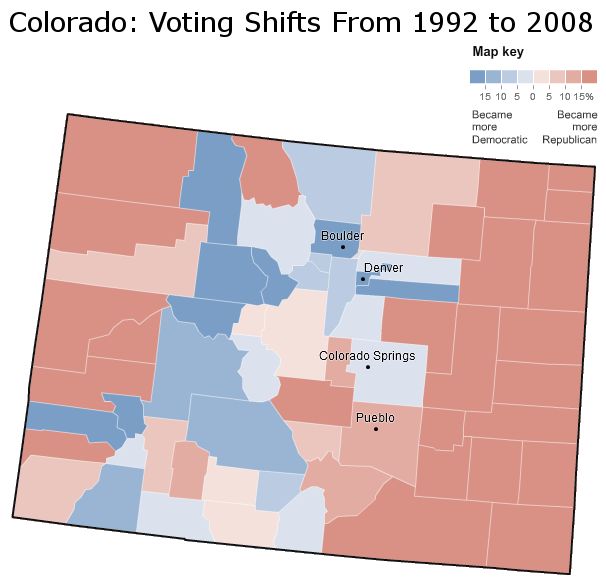This is the last part of a series of posts analyzing the swing state Colorado.
Conclusions
Colorado is much like the previous state analyzed in this series: Virginia. Both states were seen until recently as Republican strongholds and rightfully so; President George W. Bush handily won both states in 2004 and 2000.
Yet in 2004, both states showed signs of shifting Democratic. Virginia barely moved Democratic even as the South swung heavily against Senator John Kerry. As for Colorado – it actually shifted 3.7% more Democratic, against the national tide. Indeed, in 2004 Mr. Kerry performed better in Colorado than he did in Florida.
More below.
This shift cumulated in the 2008 presidential election, which showed both Colorado and Virginia as influential swing states. Colorado has thus turned from a red state into a purple state. In doing so, the Democratic Party has carved out the following coalition:
Democratic gains since 1992 follow the “C” pattern that was also present in the actual 2008 county results. This is a pattern that is present in other parts of the country, as previous posts have observed. Democrats have generally improved along the Front Range, and especially in the Denver metropolis. They have also gained in two Republican strongholds: Colorado Springs and neighboring Douglas County.
On the other hand, Republicans have gained in several historically Democratic-voting Hispanic counties near Pueblo. They have also improved in the thinly populated rural stretches of east and west Colorado.
All in all, these changes have benefited Democrats more. This is because their gains have been in the more populated areas of Colorado:
The heart of Colorado is therefore in the Denver metropolis, as the map indicates. Since 1992 Democrats have improved in all but one of the orange and red counties. In 2000 Mr. Bush won seven of the eleven highlighted counties. In 2008 Mr. Obama won seven of them. This is responsible for Colorado’s 17.3% leftward shift from 2000 to 2008.
This leftward shift has not turned Colorado into a blue state, but rather into a vitally important swing state. Say, for instance, that Mr. Obama had tied Senator John McCain in the popular vote. North Carolina and Indiana would have immediately flipped Republican. This would be followed by the traditional swing states Florida and then Ohio. Virginia would flip Republican next; Mr. Obama would lose by less than a percent. At this point Mr. McCain would have 262 electoral votes.
And there he would remain. In a tied election, Colorado would go by 1.7% to Mr. Obama, handing the senator 278 electoral votes and the presidency.
In the 2008 presidential election, therefore, Colorado was the most important state to win. It may remain thus in 2012.
–Inoljt, http://mypolitikal.com/


I don’t know much about Colorado. But I expected Dems to be improving there.
I recall that Nate Silver considered Virginia to be the swing state in the election, in that, if Virginia had gone for McCain, enough other states would have done so to give him a majority of electoral votes.